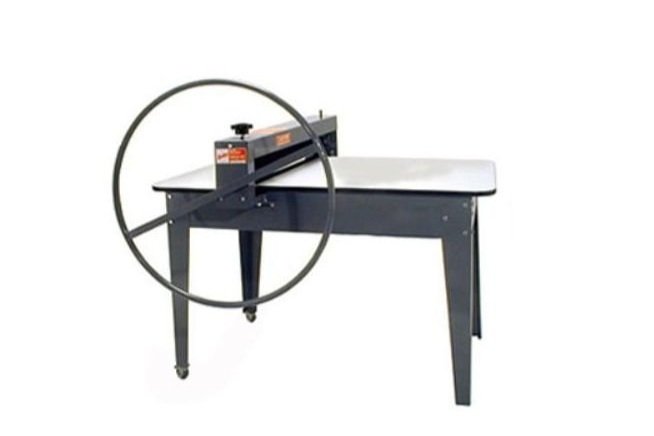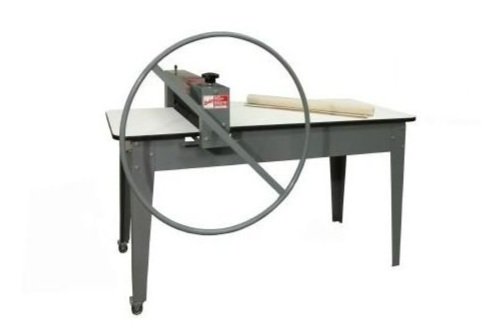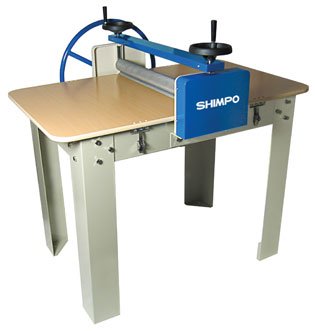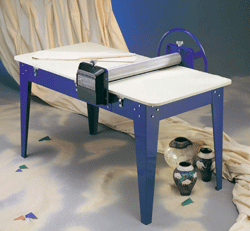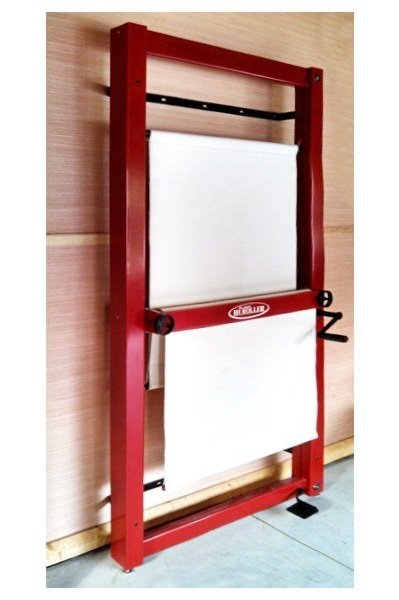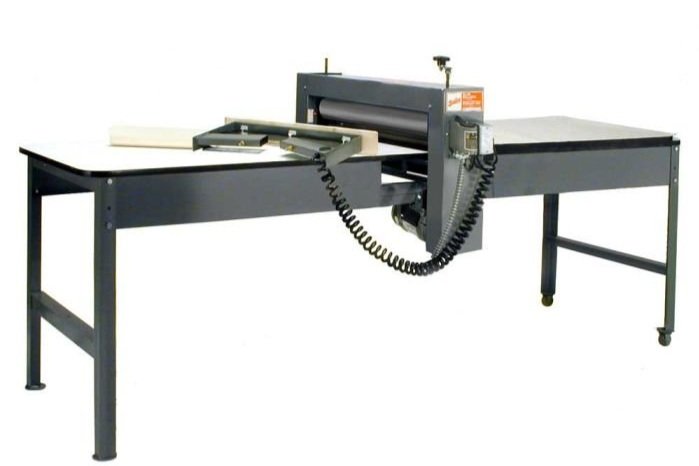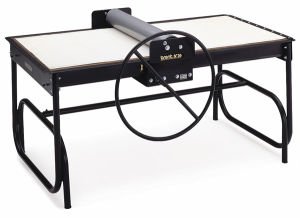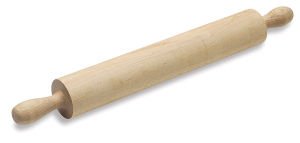The Bailey DRD / II gear reduction slab roller pictured here with the shorter 51” table.
Slab rollers are great for slab-built pottery, tiles, and sculptures. While you might be able to get by with a rolling pin, if you use slabs regularly, a slab roller should be an integral part of your studio And while full-size slab rollers can take up a chunk of space, having the ability to easily make slabs is worth it.
This post covers all the full-size slab rollers on the market from five manufacturers: Bailey, Nidec Shimpo, North Star, Brent, and the Hi Roller. For a guide to smaller portable or table top slab rollers, click here.
Top Pick: Bailey DRD / II Gear Reduction models
The 24 inch wide Bailey DRD / II slab roller pictured here with the 69” table. Note the two wheels for ease of moving the table.
The Bailey DRD / II slab rollers with the gear reduction feature are the best slab rollers on the market. These slab rollers are a joy to use, can quickly take up to 2 inches of clay down to an even slab, and are extremely durable and long lasting, suitable for a professional, academic, or personal studio.
The machine features steel rollers, a large 34” wagon wheel handle for easy turning, and one adjustment knob that raises and lowers the top roller. The slab roller can be adjusted from an ultra-thin 1/16” up to 1 1/2” .
This machine feature a reverse-thread handle adapter to prevent damage to the machine, but be careful—what this means in practice is that you can unscrew the wagon wheel handle and it will fall off. (Make sure students are trained on this machine.) On the shorter 51” table, the 34” handle is quite large but it is easy to use and turn, even with large amounts of clay.
The only other (small) drawback is that if one is not careful, canvas can be pulled under the feed table and ends up wrapping around the bottom roller. But once one is accustomed to the roller, it becomes second nature to avoid this.
Bailey makes a few different rollers, but the DRD / II gear reduction models are what you want. The cost about $100 extra for the gear reduction but they are simply the best slab roller on the market.
The Bailey DRD / II gear reduction models are available in a 24” width as a machine only ($1,380), with a 51” table ($1,780), or a 69” table ($1,999). The 30” models have the same option and generally cost about $200 more.
Budget Pick: Nidec Shimpo SR-3050 Slab Roller
The Nidec-Shimpo Slab Roller
The Nidec-Shimpo SR-3050 slab roller is a studio workhorse that will turn out great slabs. It features a double roller that sits in the middle of a 30 x 50 inch table with a wagon-wheel handle. Slab thicknesses can range from an ultra-thin 0.1” up to 3 inches, and the top roller is adjusted by moving the two handles.
Adjusting the two rollers can be a bit annoying and the table is somewhat small, but all things considered, this is a great roller that is listed around $1,100 and often can be found for around $900. The short feed area can be fixed by adding a wing or placing the machine next to another table.
The Bailey DRD II and the Shimpo slab roller are just two of many full-sized slab rollers on the market. Keep reading for a complete guide, or click here to read about small and portable table top rollers.
Table of Contents
Top Pick: Bailey DRD / II Gear Reduction Roller
Budget Pick: Shimpo Slab Roller
How to Shop For a Slab Roller
North Star Slab Rollers
The Hi Roller Vertical Slab Roller
All Bailey Slab Rollers
Brent Slab Rollers
Slab Accessories
Summary
How To Shop For A Slab Roller
It can be confusing to shop for a slab roller, as Bailey and North Star in particular make a variety of slab rollers that can be ordered with a variety of table sizes and features. Here’s a guide of how to shop and pick out rollers.
1. Start With Roller Width
Full size table top rollers range from 24 to 40 inches wide. In practice, your widest slab will probably be about 2 inches less than that. Even a 22 inch wide slab can be quite large! But if you are doing large tile projects, the 30 or 40 inch models will be needed. For an individual studio, a 24 inch roller might be quite large—maybe a table top roller is what you need.
2. Table Size
The important considerations here are the size of the table where you feed in the clay, the size of the “output” area, and the total size of the table. In addition to width, the table size will determine how long of a slab you can make. Once again, I’d suggest that a 22” wide slab by say 24” long is quite large! But if you have a larger table, you have more working area.
Shimpo, Brent, and the Hi Roller machines come in one size. But Bailey and North Star let you choose the table size. With Bailey it’s a 51” or 69” long table, and North Star options are 48” or 72” inches, and North Star also sells prop-up “wings” that extend the table. With Bailey and North Star, you can also buy the machine only and build your own table.
With any roller, measure the complete table and make sure it is suitable for your studio.
3. Rollers
Most high-quality rollers have a double roller. This will give your slab pressure from both sides, and results in a more even slab. Brent Rollers just have a roller on one side, which along with the heaviness of the table is why we don’t recommend Brent rollers.
4. Handle / Crank Mechanism
Most of these large rollers come with a wagon wheel handle, but some have a crank. A wagon wheel makes it easy to turn, but does take up more room. Consider the Bailey rollers with the short table: a 34” wide wagon wheel handle is paired with a 51” table. It’s a bit crowded. Smaller table top rollers generally have a crank rather than a wagon wheel.
5. Gear Reduction / Safety Mechanisms
Any slab roller should be treated with respect and they can be damaged if they are turned the wrong way or too much clay is forced through the rollers. Bailey makes a gear-reduction model that is even easier to turn, and also has a reverse-threaded wagon wheel so that you can’t turn the gears the “wrong” way and damage the machine.
6. Durability
All of the machines reviewed here are well built and will be long lasting if not abused. In my experience, the Bailey, Shimpo, and North Star machines hold up best under intense use in academic or community studios. The Hi Roller is fussy but can make nice albeit small slabs. The Brent rollers are extremely heavy and basically bomb proof welded steel, but if the shims get wet they can warp and the wires can snap if used improperly. So many academic studios have Brent rollers but the other four manufacturers make machines that are simpler, lighter, and easier to maintain.
North Star Slab Rollers
The North Star 30 inch wide Super Roller with table.
North Star makes two styles of slab rollers: the “standard” line has crank-driven 2 1/2” double rollers available in 18”, 24”, and 30” width as machine only, table-top portarollers, or in 48” long tables. (Our top pick for a portable roller is the 18” Portaroller from the North Star standard series.) The two larger rollers in the standard line can also be ordered with wagon wheel handles.
The “super” series features wagon-wheel driven 4” wide double rollers with a gear reduction in 24”, 30”, or 36” width in 72” long tables. If you are a production shop or a busy academic studio, the Super series is what you want, whereas the standard line is great for individual studios.
North Star also makes a variety of accessories, such as fold-out wings to extend the length of tables, and extra shelves for the roller table.
These are great rollers. The only drawback compared to the Bailey DRD / II models is that North Star has two height adjustment knobs, rather than one that moves the entire top roller. North Star mentions that this makes “tapered slabs” possible, but truth be told, that’s a concept I’ve only heard mentioned in their marketing copy.
North Star Standard rollers range from around $1100 to $1200 for a roller and table.
Super series rollers start at around $1500 for the 24” roller and table, and go up to $2355 for the 36” roller and table. All the models are available for less as machine only, if you want to build your own table.
The Hi Roller Vertical Slab Roller
The Hi Roller Vertical Slab roller is a space-saving machine that is easy to crank.
The Hi Roller is an interesting entry for the full size slab roller because it can be wall mounted or stand on its own, taking up very little space while providing great (if somewhat small) slabs. The rollers can be adjusted easily with a dial, clay is placed near the rollers, and a small crank easily moves the clay down between two pieces of canvas. Then, the clay is cranked back up, often sticking just enough to the canvas until you remove it.
This all sounds great, but in practice, this is a fussy machine. Sometimes the clay drops below the rollers and won’t come back up, and it’s hard to make large slabs. So there is some trade off but if floor space is a premium in your studio, this is the roller for you.
The Hi Roller is generally available for around $1,450-$1,500.
Bailey Slab Rollers
Bailey makes a somewhat confusing array of slab rollers so hopefully this outline of their product line will help.
The Bailey 40” DB Drive Board roller with electric motor.
The DRD / II slab roller from Bailey is the top pick for a slab roller (see top of post) and is available in a 24” or 30” model in either direct drive or gear reduction models. It’s worth the extra $100 for the gear reduction—why not make it easier to crank out slabs? The DRD / II models have 2 1/2 inch diameter rollers.
The original DRD model is still in production, and is available in 30” or 40” width. The DRD features 4” diameter rollers, designed for professional studios or heavy use by academic studios. These are amazing, big rollers. They are also available with electric motors.
Finally, Bailey also makes the DB or Drive Board rollers in 30” or 40” widths. These machines have a single roller on top and a drive board that travels with the slab, allowing for more even compression and protecting the slab from bunching or bogging down in the machine. These are best for tile and architectural tile work.
Brent Slab Rollers
The Brent SR-30 Slab Roller
Brent makes three slab rollers with a wagon wheel (the SR-14, SR-20, and SR-30) and one model (the SRC) with a crank handle. All are rather overbuilt with heavy steel bases, and single wheels that move over the top of the slabs, and have wires underneath the roller table covered in sticky grease. The slab thickness is adjusted by adding or removing canvas-covered shims.
These slab rollers are quite common but I would avoid them whether new or used. Here’s why:
> Adding or taking out shims is a pain. Also, this process generally results in a lot of dust being created.
> Single roller, only pressure from the top rather than a double roller.
> Heavy. So heavy. You’ll need a forklift or about 6 people to move these. They are unnecessarily heavy.
> Hard to maintain. Have fun repairing the guide/crank wire when it snaps! (Misuse by students can easily break this wire)
> Warped shims: I once used a Brent roller that had water damage and all the shims were warped, resulting in uneven slabs.
And finally, expensive. All that metal costs money. These rollers ranged from $2,000 up to $3,700. Sure, if properly maintained and used you will get fine slabs, especially if you never change the slab thickness. But any other machine will be better.
Slab Accessories
A few things that will make working with slabs easier:
Slab Mats
Slab mats are available in a variety of sizes and are great for rolling slabs or handbuilding.
Slab Mats are a plastic fabric with one side smooth and the “working” side has a bit of a fuzz. They are less flexible than canvas, but are also great for putting through rollers, moving slabs around, or just as a working surface to protect your table tops. Most normal clay uses (fettling knives, craft knives, needle tools, etc) won’t cut through these. Small sizes can also be used as small bats for handbuilding, or get a larger piece to run through your roller.
Canvas
Unprimed, raw canvas is a great working surface that can be laundered.
For slabs, unprimed canvas is also great for rolling and moving around the studio. With a canvas blanket, you can cut to your desired shape and either hem or leave the edges unhemmed. Canvas can be washed over and over again by hand or in the washing machine. Frequent washing will help keep the dust down, and does soften the material over time. #12 / 12 oz canvas is a great place to start, or go slightly thicker with #10 / 15oz canvas.
Rolling Pin
A solid maple rolling pin is a useful studio tool that is easy to clean.
A solid maple rolling pin is a must-have for any ceramic studio, even if you have a slab roller. For small things, it’s usually easier to roll by hand. Pair this with a few wooden slats or yard sticks, and you’ve got an adjustable slab rolling system.
A solid rolling pin is better than a rolling pin with bearings or moving parts, because there is nothing to break and it is easy to clean the entire rolling pin with water. Rolling pins come in a variety of sizes but a 24” wide rolling pin is still easy to maneuver but large enough to make really big slabs. At around $30, this is an affordable studio tool that will last forever.
Summary
This post has covered every large or full-size slab roller on the market, including models from Bailey, North Star, Nidec-Shimpo, Hi Roller, and Brent.
The top pick is the DRD/II gear reduction slab roller from Bailey, but there are lots of options for a wide variety of budgets. All of these rollers, if properly used, will make great slabs but there are some superior options (Bailey, Shimpo, North Star) based on price, weight, and quality of features.
What slab roller do you use in your studio? Let us know in the comments.
